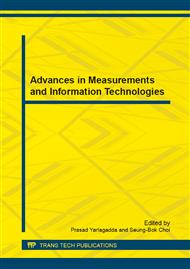[1]
Mokni N., Olivella S., Carrera J. Surface movements in a rock massif induced by drainage associated to tunnel excavation. International Journal for Numerical and Analytical Methods in Geomechanics. 2013(9), Vol. 37: P1162-1188.
DOI: 10.1002/nag.2082
Google Scholar
[2]
Berthoz N., Branque D., Wong H. Stress measurement in partially saturated soils and its application to physical modeling of tunnel excavation. Canadian Geotechnical Journal. 2013(10), Vol. 50: P1077-1087.
DOI: 10.1139/cgj-2013-0154
Google Scholar
[3]
Klar A., Osman S., Bolton M. 2D and 3D upper bound solutions for tunnel excavation using elastic, flow fields. International Journal for Numerical and Analytical Methods in Geomechanics. 2010(12), Vol. 31: P1367-1374.
DOI: 10.1002/nag.597
Google Scholar
[4]
Nguyen T., Datcheva M., Nestorovic T. Identification of a fault zone ahead of the tunnel excavation face using the extended Kalman filter. Mechanics Research Communications. 2013, Vol. 53: P47-52.
DOI: 10.1016/j.mechrescom.2013.08.003
Google Scholar
[5]
Chiocchini U., Castaldi F. The impact of groundwater on the excavation of tunnels in two different hydrogeological settings in central Italy. Hydrogeology Journal. 2011(3), Vol. 19: P651-669.
DOI: 10.1007/s10040-010-0702-1
Google Scholar
[6]
Bilotta E., Russo G. Use of a Line of Piles to Prevent Damages Induced by Tunnel Excavation. Journal of Geotechnical and Geoenvironmental Engineering. 2011(3), Vol. 137: P254-262.
DOI: 10.1061/(asce)gt.1943-5606.0000426
Google Scholar
[7]
Tiger Sun, Xianghe Peng, Shuping Jiao, Changxing Xu, Jingzhi Li. Simulation of Particle Dynamics of Nano-Magnetorheological Materials in External Magnetic Fields. Journal of Computational and Theoretical Nanoscience. 2014(6), Vol. 11: P656-661.
DOI: 10.1166/jctn.2014.3528
Google Scholar
[8]
Ran L., Yi T. H., Ye X. W. Long-Term Deformation Monitoring of Metro-Tunnel Airshaft Excavation during Construction Stage. International Journal of Distributed Sensor Networks. 2012, Article ID: 972893.
DOI: 10.1155/2012/972893
Google Scholar
[9]
Hu Sun, Xianghe Peng, Kaiyuan Guo, Jingzhi Li, Jin Huang. Magnetorheological Materials Theory System and Experimental Investigation. Materials Focus. 2013(4), Vol. 2: P283-287.
DOI: 10.1166/mat.2013.1090
Google Scholar
[10]
Wang F., Zhang D. M., Zhu H. H. Impact of Overhead Excavation on an Existing Shield Tunnel: Field Monitoring and a Full 3D Finite Element Analysis. CMC-Computers Materials & Continua. 2013(1), Vol. 34: P63-81.
Google Scholar
[11]
Sharifzadeh M., Kolivand F., Ghorbani M. Design of sequential excavation method for large span urban tunnels in soft ground - Niayesh tunnel. Tunnelling and Underground Space Technology. 2013, Vol. 35: P178-188.
DOI: 10.1016/j.tust.2013.01.002
Google Scholar
[12]
Tiger Sun, Xianghe Peng, Jingzhi Li, Chao Feng. Testing Device and Experimental Investigation to Influencing Factors of Magnetorheological Fluid. International Journal of Applied Electromagnetics and Mechanics. 2013(3), Vol. 43: P283-292.
DOI: 10.3233/jae-131700
Google Scholar
[13]
Ritter S., Einstein H. H., Galler R. Planning the handling of tunnel excavation material - A process of decision making under uncertainty. Tunnelling and Underground Space Technology. 2013, Vol. 33: P193-201.
DOI: 10.1016/j.tust.2012.08.009
Google Scholar
[14]
Tiger Sun, Shuping Jiao, Xianghe Peng, Changxing Xu, Jingzhi Li. Mechanics Modeling upon Nano-MRM for Treatment of Intracranial Aneurysm. Advanced Materials Research. 2013, Vol. 643: P135-138.
DOI: 10.4028/www.scientific.net/amr.643.135
Google Scholar
[15]
Weng M. C., Tsai L. S., Liao C. Y. Numerical modeling of tunnel excavation in weak sandstone using a time-dependent anisotropic degradation model. Tunnelling and Underground Space Technology. 2010(4), Vol. 25: P397-406.
DOI: 10.1016/j.tust.2010.02.004
Google Scholar
[16]
Hu Sun, Xiang-he Peng. Magnetorheological Materials Theory United in Energy. Applied Mechanics and Materials. 2012, Vol. 157-158: P33-36.
DOI: 10.4028/www.scientific.net/amm.157-158.33
Google Scholar


